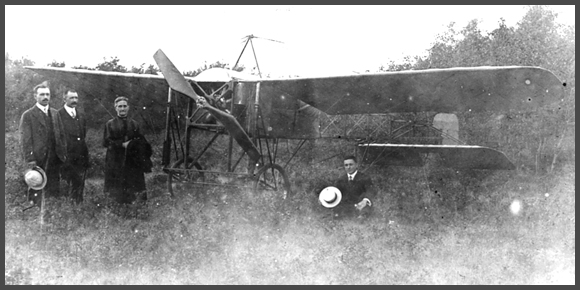by Bruce Cherney (part 2 of 2)
A November 18, 1918, Manitoba Free Press obituary for Albert Contant’s brother, Eugene, specifically mentions: “The Contant Bros. were the first in Manitoba to manufacture an aeroplane and fly it.”
“Albert Contant will be remembered as the builder of the first aeroplane built in western Canada,” according to the August 12, 1916, Free Press, “which he has flown on many occasions.”
The first account of Contant becoming airborne is found in a one-paragraph mention in the October 4, 1915, Free Press: “St. Boniface Aviator Successfully — Albert Contant, of St. Boniface, has made several successful flights in that city with a monoplane which he has entirely built himself. He has attained a flight of 1,000 feet.”
Alfred Contant, then living in Vancouver, was interviewed for a September 27, 1967, Free Press article by Sheldon Bowles and related his brother’s first flights.
Alfred said there were problems in the beginning. “It (the monoplane) first went up in 1915 and all the exhaust gas came pouring back on him along with castor oil used to lubricate the runners in which the (rotary) engine turned.”
In particular, castor oil was the preferred lubricant for the Gnome rotary engine, which powered the Contant monoplane, and other rotary engines used by the Allies’ airplanes during the First World War. Castor oil didn’t degrade (break down) as quickly as the regular motor oil produced at the time due to the high heat produced by rotary engines. Another property of castor oil was that it didn’t mix with fuel, which was absolutely essential for the operation of a rotary engine; that is, to maintain constant lubrication.
The problem was the centrifugal force of the rotating engine constantly threw oil into the pilot’s face. The scarves won by pilots flying early open-cockpit airplanes were used to wipe oil away from their faces and goggles — they weren’t a fashion accessory.
To combat the laxative effect of castor oil that was constantly being inhaled or swallowed, the early flyers also carried a flask of brandy.
“Then, on landing he broke the prop. That winter he went to work on finding a way to shield himself in and make another prop,” said Alfred. “The prop was all hand done and made out of laminated wood. It was quite a job.”
Albert was airborne regularly in 1916 and 1917.
“I remember seeing him go up,” Alfred told Bowles.
His brother was given the use of a field about six chains wide and two miles long in the outskirts of St. Boniface.
“He would go up 500 to 900 feet and circle around the bit of land he was able to borrow from the (St. Boniface Diocese) bishop. Then he would come down. I’d say he would fly five or six miles before he landed.”
Albert Contant didn’t live to witness the rapid advancements being made in aviation towards the end of the First World War, as he passed away on March 4, 1918, following an operation for a blood ailment and is buried in St. Boniface Cathedral Cemetery. He was born in 1887.
Following his death, Albert’s Bleriot-type monoplane was put into storage in the Contant Bros.’ Norwood shop where it had been built. The plane was later dismantled and all that remained as witness to the first locally-built aircraft was the Gnome rotary engine.
In 1941, Alfred Contant donated the engine to the University of Manitoba’s engineering department and in 1967, it was given to the then new Manitoba Museum of Man and Nature (today’s Manitoba Museum).
“It was amazing that he had the audacity to fly in that thing,” commented his brother, Alfred.
In a June 9, 1928, Winnipeg Evening Tribune article, by H.T. Coleman, Straith recalled the early days of aviation in Winnipeg: “In the days when I first took up airplaning we wouldn’t go aloft if there was enough breeze to flutter a handkerchief ... Then, you would look down from your perch right out on the wing and see the ground swirling below.”
Straith said the pioneer days of flying were risky, but enjoyable. In fact, Staith’s Wright machine hit some overhead wires, sending it to the ground. He spent several weeks in hospital recuperating from his injuries.
“But I would not like to return to those days,” he added. “The airplane is now safe and here to stay. Of course, those experiments of mine were fun, but you see I was younger then.”
In 1928, as the managing director of the Canadian Aviation Company, he became the first Winnipegger to specifically design, build and fly an aircraft in the city. In this case, the airplane was neither a replica made from scratch, such as Contant’s, or a modification of an existing flying machines, such as Straith’s first attempt to take to the air in Winnipeg.
Straith died in a plane crash in New Mexico while travelling on business to Mexico on April 4, 1947. At the time of his death, he was the president of the U.S.-based Inter-Continental Aerial Underwriters Company.



